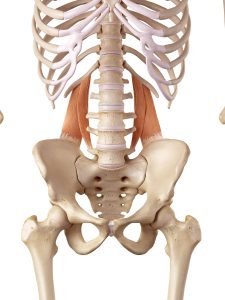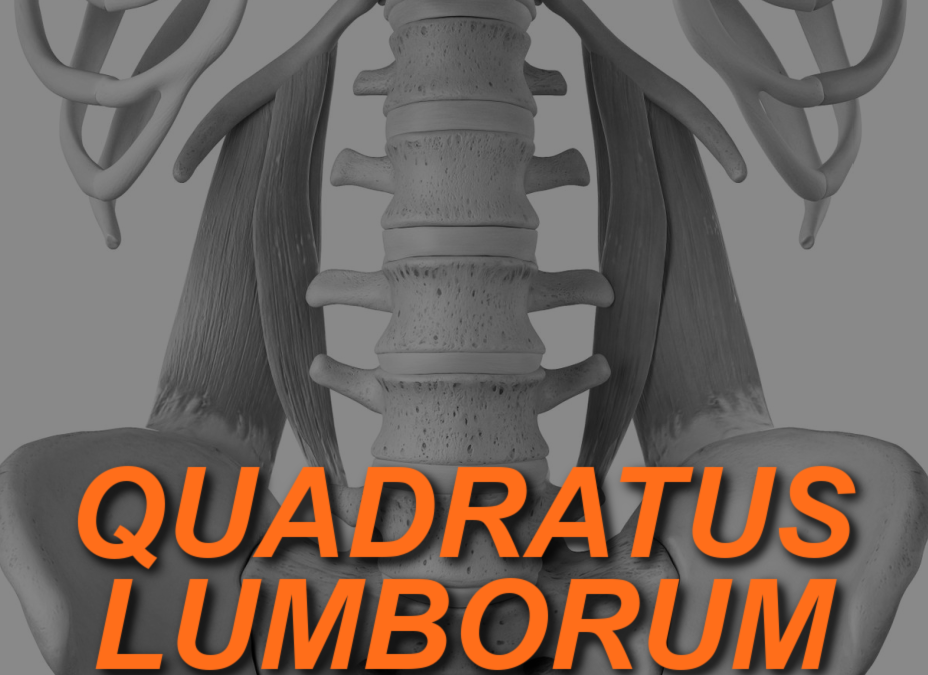The Quadratus Lumborum (QL) muscles, a common source of lower back pain, are located on either side of the lumbar spine. While they are situated at the lower back between the pelvis and the lowest ribs, and thus commonly referred to as a low back muscle, these muscles are considered to be the deepest abdominal muscles. These deep core stabilizers are used when we sit, stand, and walk, so understanding Quadratus Lumborum can give us a better understanding of the effect it has on our physical well-being, as well as the well-being of our personal training clients.
Origin and Insertion of Quadratus Lumborum
The QL originates at the posterior iliac crest and inserts at the 12th rib.

photo credit: Eraxion. quadratus lumborum
QL Function
The QL has various functions including both stabilization and movement of the spine. This muscle allows for lateral flexion of the spine as well as extension of the lumbar vertebral column; it stabilizes the pelvis, lumbar spine, and lumbosacral junction; and it contributes to elevation of the pelvis (“hip hiking”). Additionally, because of its connection to the 12th rib, the QL plays a role in breathing, supporting expiration and assisting the diaphragm during inhalation.
CONTRIBUTION TO LOW BACK PAIN
The QL muscles are often mistakenly considered to be lower back muscles because of their contribution to pain or discomfort in the lower back. Though QL is just one part of a large system of muscles and cannot be solely responsible for low back pain, its various functions can result in overuse, stress, and repetitive strain.
The lower back pain is typically described as a deep aching pain. However, depending on the cause, it can be experienced as sharp and acute.
Activities with repetitive movements, like running or cycling, can cause QL strain when core and back muscles are weak and when posture is suboptimal. Additionally, sitting for long periods of time can create stiffness and tension due to the continuous contraction and tightness in this muscle. In cases of repetitive strain and prolonged sitting, the pain is more likely to be felt as a dull ache.
Twisting and bending can create tension in the QL and, because it is a core stabilizer, the QL can become tense or tight when having to work to stabilize the spine and pelvis.
As with any muscle, the QL can also become acutely injured. Sports, daily activities, heavy lifting, or accidents can cause trauma to this muscle.
Whether it is chronic or acute, QL pain can be disruptive when performing everyday activities like walking, sitting and standing.
Posture
Posture is important to consider when the QL is tight or causing pain.
Tilting the pelvis and leaning to one side while standing or slouching while sitting can cause the QL to overcompensate to stabilize the spine and/or pelvis and aggravate it.
Using back support while sitting and finding a more neutral position for the spine and pelvis while performing any activities can protect the QL from this constant contraction and thus, spare a great deal of soreness and discomfort.
Breath and the QL
Because the QL is connected to the bottom rib, when it is tight, it can affect breathing.
A tight and stuff QL can prevent the rib cage from fully expanding on inhalation, making it challenging to take in a deep breath.
For this reason, a healthy QL plays an important role in optimizing our respiration.
Other Considerations
Its many functions and constant daily use make the Quadratus Lumborum muscle an important one to consider when training our clients.
Core and lower back strengthening can help support the QL so it is not overworked and strained unnecessarily. Special attention to posture and form must take precedence when we are strength training.
Additionally, lengthening this muscle can provide relief when it is tight. Lateral stretches, standing and seated, can help to lengthen the QL. Self-massage and myofascial release can help to relieve tension in the muscle and the surrounding tissues. Deep, intentional breathing can also help to relax an overactive muscle, as well.
Pilates and yoga classes that focus on breathing, lengthening muscles, and strengthening the core can be helpful in relieving low back pain associated with Quadratus Lumborum.
Finally, personal training clients can always use a reminder that they don’t have to live with lower back pain. Remind them to seek help from a medical professional if pain is long-lasting or severe, and that you are there to support them in the process of returning to pain-free living.
[sc name=”anatomy” ][/sc]
References
https://www.medicalnewstoday.com/articles/320497
https://www.physio-pedia.com/Quadratus_Lumborum
https://sonyagenel.com/dont-underestimate-the-quadratus-lumborum/
https://www.healthline.com/health/quadratus-lumborum-pain


